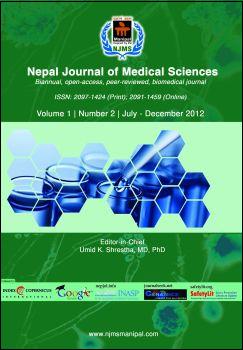Gonococcal infections: The trends of antimicrobial susceptibility of Neisseria gonorrhoeae in Western Nepal
DOI:
https://doi.org/10.3126/njms.v1i2.6603Keywords:
Antimicrobial susceptibility, gonorrhoeae, N. gonorrhoeae, urethritisAbstract
Background: Gonorrhea is caused by Neisseria gonorrhoeae, is an important public health problem and is the second most common reportable sexually transmitted bacterial infection. Present study was conducted to determine the antimicrobial resistance pattern of Neisseria gonorrhoeae isolates from various clinical specimens.
Methods: This is a hospital based retrospective study conducted at Manipal Teaching Hospital, Pokhara, Nepal. Various clinical specimens (urethral, cervical and conjunctival discharges) were collected from the suspected cases of gonococcal infections between January 2004 to December 2010. Specimens were subjected to Gram stain and culture on chocolate agar. Antibiotic susceptibility testing was performed on chocolate agar by Kirby Bauer’s disc diffusion method.
Results: A total of 119 patients were tested for gonococcal infections. Forty-eight patients were diagnosed as having gonococcal infections, of which 40 cases were culture positive. Penicillin resistance was seen in 27 (67%) cases while all isolates were sensitive to ceftriaxone.
Conclusion: Neisseria gonorrhoeae isolates are becoming increasingly resistant to antibiotics like penicillin, ciprofloxacin and tetracycline. Therefore, continuous surveillance of antibiotic resistance pattern is required in order to start empirical antibiotic therapy in high risk population like commercial sex workers.
DOI: http://dx.doi.org/10.3126/njms.v1i2.6603
Nepal Journal of Medical Sciences. 2012;1(2): 74-78
Downloads
Downloads
Published
How to Cite
Issue
Section
License
Copyright © by Nepal Journal of Medical Sciences. The ideas and opinions expressed by authors of articles summarized, quoted, or published in full text in this Journal represents only opinions of authors and do not necessarily reflect the official policy of Nepal Journal of Medical Sciences or the institute with which the author(s) is (are) affiliated, unless so specified.




